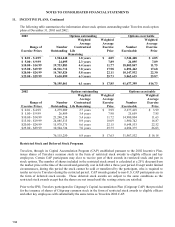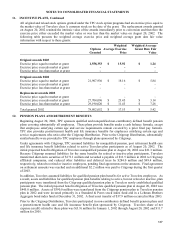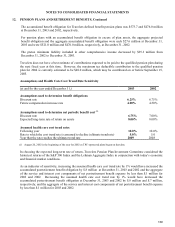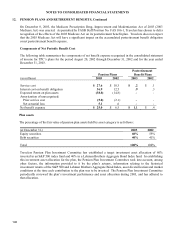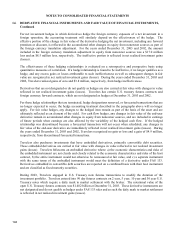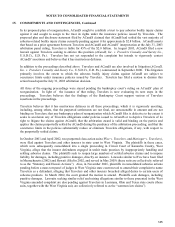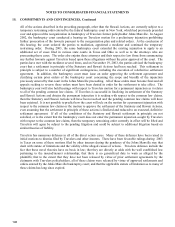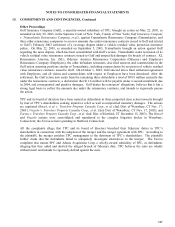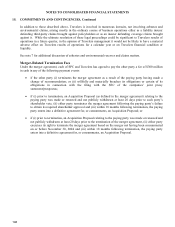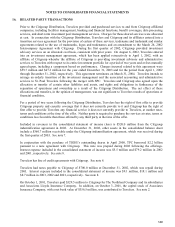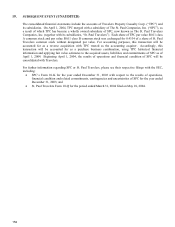Travelers 2003 Annual Report Download - page 144
Download and view the complete annual report
Please find page 144 of the 2003 Travelers annual report below. You can navigate through the pages in the report by either clicking on the pages listed below, or by using the keyword search tool below to find specific information within the annual report.142
NOTES TO CONSOLIDATED FINANCIAL STATEMENTS
14. DERIVATIVE FINANCIAL INSTRUMENTS AND FAIR VALUE OF FINANCIAL INSTRUMENTS,
Continued
For net investment hedges in which derivatives hedge the foreign currency exposure of a net investment in a
foreign operation, the accounting treatment will similarly depend on the effectiveness of the hedge. The
effective portion of the change in fair value of the derivative hedging the net investment, including any forward
premium or discount, is reflected in the accumulated other changes in equity from nonowner sources as part of
the foreign currency translation adjustment. For the years ended December 31, 2003 and 2002, the amount
included in the foreign currency translation adjustment in equity from nonowner sources was a $17.0 million
loss and an $8.5 million loss, respectively. The ineffective portion is reflected in net realized investment gains
(losses).
The effectiveness of these hedging relationships is evaluated on a retrospective and prospective basis using
quantitative measures of correlation. If a hedge relationship is found to be ineffective, it no longer qualifies as a
hedge, and any excess gains or losses attributable to such ineffectiveness as well as subsequent changes in fair
value are recognized in net realized investment gains (losses). During the years ended December 31, 2003 and
2002, Travelers realized gains of zero and $3.8 million, respectively, from hedge ineffectiveness.
Derivatives that are not designated or do not qualify as hedges are also carried at fair value with changes in value
reflected in net realized investment gains (losses). Travelers has certain U.S. treasury futures contracts and
foreign currency forward contracts, which are not designated as hedges at December 31, 2003 and 2002.
For those hedge relationships that are terminated, hedge designations removed, or forecasted transactions that are
no longer expected to occur, the hedge accounting treatment described in the paragraphs above will no longer
apply. For fair value hedges, any changes to the hedged item remain as part of the basis of the asset and are
ultimately reflected as an element of the yield. For cash flow hedges, any changes in fair value of the end-user
derivative remain in accumulated other changes in equity from nonowner sources, and are included in earnings
of future periods when earnings are also affected by the variability of the hedged cash flow. If the hedged
relationship was discontinued because a forecasted transaction will not occur when scheduled, any changes in
fair value of the end-user derivative are immediately reflected in net realized investment gains (losses). During
the years ended December 31, 2003 and 2002, Travelers recognized no gain or loss and a gain of $4.9 million,
respectively, from discontinued forecasted transactions.
Travelers also purchases investments that have embedded derivatives, primarily convertible debt securities.
These embedded derivatives are carried at fair value with changes in value reflected in net realized investment
gains (losses). Travelers bifurcates an embedded derivative where: a) the economic characteristics and risks of
the embedded instrument are not clearly and closely related to the economic characteristics and risks of the host
contract, b) the entire instrument would not otherwise be remeasured at fair value, and c) a separate instrument
with the same terms of the embedded instrument would meet the definition of a derivative under FAS 133.
Derivatives embedded in convertible debt securities are reported on a combined basis with their host instrument
and are classified as fixed maturity securities.
During 2003, Travelers engaged in U.S. Treasury note futures transactions to modify the duration of the
investment portfolio. Travelers entered into 90 day futures contracts on 2 year, 5 year, 10 year and 30 year U.S.
Treasury notes which require a daily mark to market settlement with the broker. The notational value of the
open U.S. Treasury futures contracts was $1.482 billion at December 31, 2003. These derivative instruments are
not designated and do not qualify as hedges under FAS 133 rules and as such the daily mark to market settlement
is reflected in net realized investment gains (losses).




